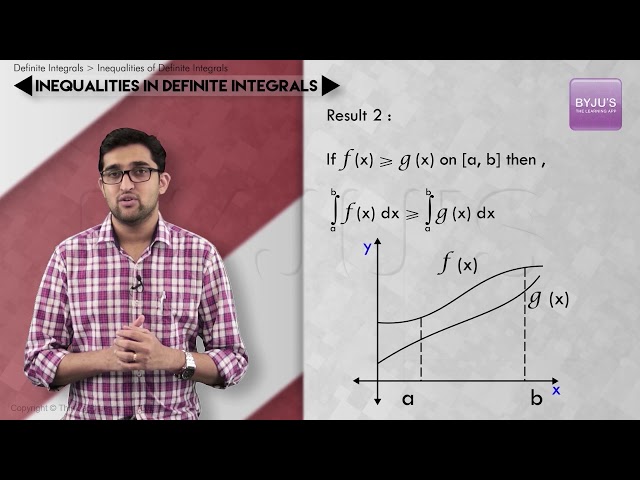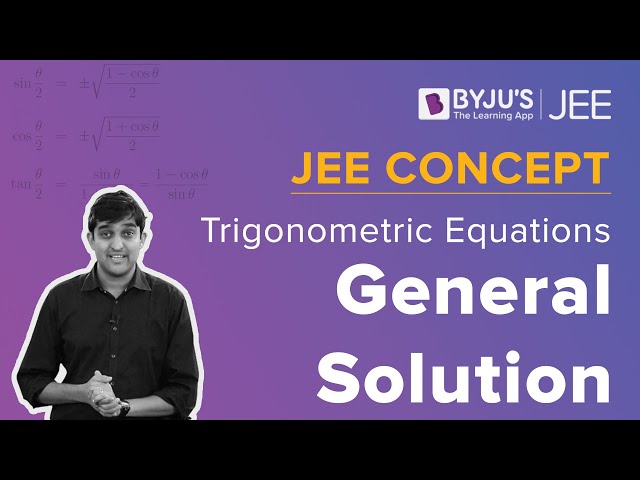JEE Main 2020 Maths Paper With Solutions Shift 2 September 3
a) √e/2
b) (3/2)√e
c) (1/2)+√e
d) (3/2)+√e
(x3-x2)dy = (2-x) ydx
p = 1, q = 2, r = -1
ln|y| = -ln x+(2/x)+ln (x-1)+c
x = 2, y = e
1 = 1-ln 2+c
⇒ c = ln 2
ln|y| = (2/x)-ln |x|+ln |x-1|ln 2
put x = 4
ln|y| = (1/2)-2ln 2+ ln 3+ ln 2
ln y = ln(3/2)+(1/2)
y = (3/2)×e1/2
= (3/2)√e
Answer: b
a) (9, 1/81)
b) (9, 1/9)
c) (3, 1/81)
d) (3, 81)
adj A =
⇒ |adj A| = 9
⇒ |A2| = 9
⇒ |A| = 3 = |λ| and |A| = -3 = |λ|
det (adj (adj A)) = ((|A|)(n-1))2
|B| = ((|A|)(3-1))2 = |A|4 = 34 = 81
|(BT)-1| = 1/|(BT)|
= 1/|B|= 1/81=μ
Hence |λ|,μ = (3, 1/81)
Answer: c
a) π/2
b) 2π/3
c) π/9
d) 0
cos α =
= (ab+bc+ca)/a2+b2+c2
= (ab+bc+ca)/1
cos α = ab+bc+ca
cos α = abc[(1/a)+(1/b)+(1/c)] ..(i)
a cos200 = b cos(1400) = c cos(2600) = λ
⇒ (1/a) = cos 200/λ
(1/b) = cos 1400/λ
(1/c) = cos 2600/λ
Put in (i)
⇒ cos α = (abc/λ)(cos 200+ cos 1400+ cos 2600)
⇒ cos α = (abc/λ)(cos 200+ 2cos 2000+ cos 600)
⇒ cos α = (abc/λ)(cos 200– cos 200)
⇒ cos α = 0
⇒ α = π/2
Answer: a
a) 6
b) 2
c) 8
d) 4
f’(x) = k(x+1)x(x-1)
f’(x) = k[ x3-x]
Integrating both sides
f(x) = k[(x4/4)- (x2/2)]+c
f(0) = c
f(x) = f(0) ⇒ k[(x4/4)- (x2/2)]+c = c
⇒ k(x2/4)(x2-2) = 0
⇒ x = 0, √2, -√2
Sum of squares of all elements = 02+(√2)2+(-√2)2
= 4
Answer: d
a) 2√3+π
b) 3√2+π
c) 3√2-π
d) 2√3-π
Put x = sinθ
=
⇒ (1/√3)-(π/6) = k/6
(2√3-π)/6 = k/6
k = 2√3-π
Answer: d
a) 5
b) 9
c) 7
d) 11
Tr+1 =
=
18-3r = 0
⇒ r = 6
=
⇒ 7/18 = k
⇒ 18k = 7
Answer: c
a) (-3,3)
b) (-3/5, 3/5)
c) (3/5, -3/5)
d) (3,-3)

mAH. mBC = -1
⇒ ((y-7)/(x+1))(1+5)/(-7-5) = -1
⇒ 2x-y+9 = 0 …..(i)
and mBH. mAC = -1
((y-1)/(x+7))(7–5)/(-1-5) = -1
x-2y+9 = 0 …..(ii)
Solving equation (i) and (ii) we get
(x, y) = (-3,3)
Answer: a
a) (8,12)
b) (24/5,10)
c) (20/3,12)
d) (8,10)
α = 10e1
b2 = 25(1-e12)
β = 8e2
b2 = 16(e22-1)
(e1e2)2 = 1
(1-b2/25)( 1+b2/16) = 1
⇒ 1+(b2/16)-(b2/25)-(b4/400) = 1
⇒ (9b2/16×25)-(b4/400) = 0
⇒ 9b2-b4 = 0
⇒ b2(9-b2) = 0, b ≠ 0
Therefore, 9-b2 = 0
b2 = 9
e1 = 4/5
α = 2ae1
= 10×4/5
= 8
e2 = 5/4
β = 2ae2
= 8×5/4
= 10
(α, β) = (8, 10)
Answer: d
a) 2√3
b) 2/√3
c) 1/√3
d) √3/2
z1 = x1+iy1
z2 = x2+iy2
x12 = (x1-1)2+y12
⇒ y12-2x1+1 = 0 ..(i)
x22 = (x2-1)2+y22
⇒ y22-2x2+1 = 0 ..(ii)
From equation (ii)-(i)
(y12-y22)+2(x2-x1) = 0
(y1+y2)(y1-y2) = 2(x1-x2)
(y1+y2) = 2(x1-x2)/ (y1-y2)
arg (z1-z2) = π/6
tan-1(y1-y2)/(x1-x2) = π/6
⇒ (y1-y2)/(x1-x2) = 1/√3
So y1+y2 = 2√3
Answer: a
a) (-3,-1)
b) (2,4)
c) (1,3)
d) (0,2)
f(0) f(1) ≤ 0
⇒ (2) [λ2-4λ +3] ≤0
(λ-1)(λ- 3) ≤0
⇒ λ ε [1, 3]
at λ = 1
2x2 -4x+2 = 0
⇒ (x-1)2 = 0
x = 1, 1
⇒λ ε (1, 3]
Answer: c
a) 8
b) 8√5
c) 4√5
d) 12

C1C2 = 2C1A
(C1A)2 + 4 = ( 2√5)2
C1A = 4
C1C2 = 8
Answer: a
a) (0,-1,1)
b) (4,0,1)
c) (4,0,-1)
d) (0,1,-1)

a = 2, b = -6
c = 4
Equation of plane is
2(x-3)+(-6)(y -1)+ 4(z-1) = 0
⇒ 2x-6y+4z = 4 passes through (4, 0, -1).
Answer: c
a) (2/9)4/3
b) (2/3)4/3
c) (2/3)(2/9)1/3
d) (2/9)(2/3)1/3
Apply L hospital rule

⇒ [(2/3)(3a)-2/3-1/32/3(a-2/3)]/[(1/3)(4a)-2/3-(1/3)41/3a-2/3]
= (2/3)×(2/9)1/3
Answer: c
14. Let xi (1≤ i ≤10)be ten observations of a random variable X. If
where 0 ≠ p εR , then the standard deviation of these observations is :
a) 7/10
b) 9/10
c) √(3/5)
d) 4/5
Standard deviation is free from shifting of origin
S.D = √variance
= √[(9/10)-(3/10)2]
= √[(9/10)-(9/100)]
= √(81/100)
= 9/10
Answer: b
is :
a) 134/104
b) 121/104
c) 135/104
d) 50/104
Total case = 9(104)
First case : Choose two non-zero digits = 9C2
Now, number of 5-digit numbers containing both digits = 25-2
Second case : Choose one non-zero and one zero as digit = 9C1
Number of 5-digit numbers containing one non-zero and one zero both = 24-1.
fav. case = 9C2(25-2)+ 9C1(24-1)
= 1080+135
= 1215
Probability = 1215/9×104
= 135/104
Answer: c
a) (x+1, -√x)
b) (x-1, -√x)
c) (x+1, √x)
d) (x-1, √x)

Given
∫tan-1√x. 1 dx
Here tan-1√x is the first function and 1 dx is the second function.
Integrating we get
(tan-1√x)x-∫(x/1+x)×(1/2√x)dx
Put x = t2
dx = 2t dt
(tan-1√x)x-∫(x/1+x)×(1/2√x)dx = x(tan-1√x)- ∫(t2)(2tdt)/(1+t2)2t
= x(tan-1√x)-t+tan-1t+c
= x(tan-1√x)-√x+tan-1√x+c
= tan-1√x(x+1)-√x+c
A(x) = x+1
B(x) = -√x
Answer: a
a) n = 60
b) n = 41
c) nth term is -4
d) nth term is
Sn = 488
⇒ (n/2)(2×20+(n-1)(-2/5)) = 488
⇒ 20n-(n2/5)+(n/5) = 488
⇒ 100n-n2+n = 2440
⇒ n2-101n+2440 = 0
⇒ n = 61 or 40
For n = 40, Tn = 20+39(-2/5) = +ve
n = 61, Tn = 20+60(-2/5) =20-24 = -4
Answer: c
a) F, T, F
b) T, F, T
c) T, T, F
d) T, T, T
(p˄q) -> (∼q˅r) possible when p˄q -> T
∼q˅r -> F
p -> T ; p˄q⇒ T
q -> T ; ∼q˅r -> F˅F ⇒ F
r -> F ; T F ⇒ F
Answer: c
a) 9
b) 10
c) 18
d) 20
A = 6a2
A is the side of cube.
dA/dt = 6×2a da/dt
⇒ 3.6 = 12×10 (da/dt)
⇒ (da/dt) = 3/100
V = a3
dV/dt = 3a2da/dt
= 3×100×3/100
= 9 cm3/sec
Answer: a
20. Let R1 and R2 be two relations defined as follows:
R1 = {(a,b) ∈ R2: a2+b2 ∈ Q} and
R2 = {(a,b) ∈ R2: a2+b2 ∉Q}, where Q is the set of all rational numbers. Then :
a) R1 is transitive but R2 is not transitive
b) R1 and R2 are both transitive
c) R2 is transitive but R1 is not transitive
d) Neither R1 nor R2 is transitive
For R1
Let a = 1+√2, b = 1-√2, c = 81/4
aR1b ⇒ a2+b2 = (1+√2)2+(1-√2)2 = 6 ∈ Q
bR1c ⇒ b2+c2 = (1-√2)2+(81/4)2 = 3 ∈ Q
aR1c ⇒ a2+c2 = (1+√2)2+(81/4)2 = 3+4√2 ∉Q
R1 is not transitive
For R2
Let a = 1+√2, b = √2, c = 1-√2
aR2b ⇒ a2+b2 = 5+2√2 ∉Q
bR2c ⇒ b2+c2 = 5-2√2 ∉Q
aR2c ⇒ a2+c2 = 6 ∈ Q
R2 is not transitive
Answer: d
3, …., 243 (m A.M)
d = (b-a)/(n+1)
= (243-3)/(m+1)
= 240/(m+1)
4th AM = 3+4d
= 3+4(240/m+1)
3, …, 243 (3G.M)
243 = 3r4
r = 3
2nd G.M = ar2 = 27
Given that 4th A.M. is equal to 2nd G.M.
3+(960/m+1) = 27
= 960/m+1 = 24
⇒ m = 39
Answer: 39
= (-1, 1 ,1)
Equation of plane
-1(x -1)+1(y-0) +1(z-0) = 0
⇒x-y-z-1 = 0
Foot of the perpendicular from m (1,0,1)
(x-1)/1 = (y-0)/-1 = (z-1)/-1 = -(1-0-1-1)/3
(x-1) = 1/3
y/-1 = 1/3
(z-1)/-1 = 1/3
x = 4/3
y = -1/3
z = 2/3
⇒α = 4/3
β = -1/3
γ= 2/3
α+β+ γ= (4/3)-(1/3)+(2/3) = 5/3
3(α+β+γ) = 5
Answer: 5
23. Let S be the set of all integer solutions, (x, y, z), of the system of equations
x-2y+5z = 0
-2x+4y+z = 0
-7x+14y+9z = 0
such that 15≤x2+y2+z2≤150. Then, the number of elements in the set S is equal to:
x-2y+5z = 0…..(i)
-2x+4y+z = 0….(ii)
-7x+14y+9z = 0…..(iii)
2.(i) + (ii) we get z = 0, x = 2y
15 ≤4y2+y2 ≤150
⇒ 3≤y2≤30
y ∈ [-√30, -√3] U [√3, √30]
y = 2, 3, 4, 5, -2, -3, -4, -5
Number of elements in S is 8.
Answer: 8
Let xyz be 3 digit number
x+y+z = 10 where x ≥1, y ≥0, z ≥0
x-1≥0
Put x-1 = t
t≥0
⇒ t+ y+z = 9
9+3-1C3-1 = 11C2 = 55
But for t = 9, x = 10 not possible
Total numbers = 55 – 1 = 54
Answer: 54
Tangent at (c, ec)
y-ec = ec(x-c) ….(i)
normal to parabola y-2 = -1(x-1)
x+y = 3 …(ii)
At x-axis y = 0
in (i), x = c-1
in (ii), x = 3
c-1 = 3
⇒ c = 4
Answer: 4
Video Lessons – September 3 Shift 2 Maths




Comments